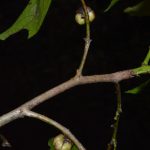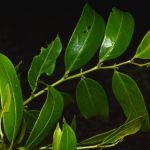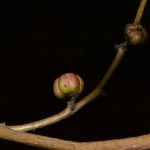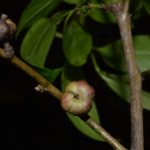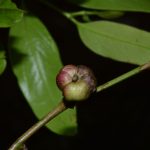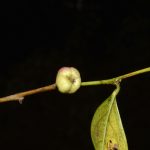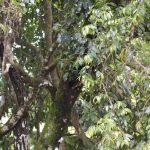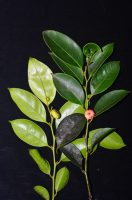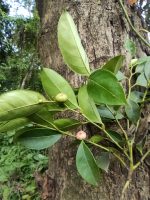|
Glochidion lanceolarium (Roxb.) Voigt. (syn: Bradleia lanceolaria Roxb.; Diasperus benthamianus Kuntze; Diasperus lanceolarius (Roxb.) Kuntze; Glochidion cantoniense Hance; Glochidion macrophyllum Benth.; Glochidion subsessile var. birmanicum Chakrab. & M.Gangop.; Glochisandra acuminata Wight; Phyllanthus benthamianus Müll.Arg., nom. illeg.; Phyllanthus fraxinifolius G.Lodd., nom. subnud.; Phyllanthus lanceolarius (Roxb.) Müll.Arg.) as per efi thread;
.
Assam; Bangladesh; Cambodia; China South-Central; China Southeast; East Himalaya; Hainan; India; Laos; Myanmar; Nepal; Thailand; Vietnam as per Catalogue of Life;
.
Location: Dahachok, Kathmandu
Date: 23 June 2020
Elevation: 1600 m.
Habitat: Wild
Is this Glochidion ??
Looks like Glochidion acuminatum.
Elevation and phenology is ok … ? Glochidion triandrum is native to Philippines. I have no idea that this species is occurring in Nepal in natural conditions. Never seen any specimen. Hence I am unable to make any further comment.
OK … I think the author has jumbled G. acuminatum with G. triandrum which belongs to subgen. Kirgalenia characterized by fleshy fruits. Here the fruits are dry and your plant should be G. acuminatum. OK … These images look different from other images at Glochidion acuminatum
The only other option is Glochidion nubigenum but I am not sure. Please also try Glochidion bourdillonii subsp. bhutanicum. If not that then further detailed studies are required. Glochidion bourdillonii subsp. bhutanicum is not listed in Nepal !
Glochidion lanceolarium (Roxb.) Voigt ??? or G. trivandrum ??
Not G. lanceolarium. What is G. trivandrum I do not know. I suggest further studies. OK …! My mistake! I mean to say G. triandrum! I really do not know G. triandrum. Some links …! But I am not sure about whatever published in the book of Nepal !
Attachments (2) This species was described from Philippines. Fl. China is also listing this species in India and Nepal. Unfortunately I have not seen any specimen. At least it does not occur in India. Only confusion is book from Nepal Govt. mentioning G. acuminatum as syn which does not look like correct! I have obtained herbarium image from National Herbarium for Glochidion assamicum (Müll.Arg.) Hook.f. . Does it look like matching?? Glochidion assamicum is now a synonym of G. ellipticum, characterised by shallowly 4-lobed fruits. Meanwhile I have also checked the neotype of G. triandrum from Philippines. Your plant is not that species either. The real identity can be established only through further studies. OK …! I hope not a new sp.! Who knows! Forwarding a link for your kind perusal. Thank you so much for sharing the publication. Now please decide. Is your plant not Glochidion acuminatum? I could not decide since it looks different from earlier identified Re: SK 2289 12 November 2019 !
In that case further studies required. After pursuing the publication attached by … and posts in efloraofindia, I feel it is different from both G.acuminatum and G. triandrum (GBIF).
It also looks different from Glochidion bourdillonii Gamble as per GBIF specimens.
I think it appears close to Glochidion lanceolarium as per GBIF specimens from India as below:
one, two, three, four and five Also see other references as GBIF (High resolution specimens) Plant illustrations Research Gate Flora of China FoC illustration
Hi, …, Pl. have re-look.
Looks like matching with descriptions, elevation and fruiting phenology. Certainly not G. lanceolarium. Any specific reasons it can not be G. lanceolarium ? Glochidion lanceolarium is distinct by the 5-8-locular ovary and capsules. The present images show 3-4-locular capsules. Thanks, …, How do we say from this image that it is 3-4-locular capsules and not 5-8-locular capsules ?
Images have their own limitations. I just came across doc. from Takahide Kurosawa which mention some additional sp.
Accordingly, I guess this could be Glochidion daltonii (Mull. Arg.) Kurz !
May I have your opinion please ! 5 attachments Your question is not clear to me.
Please elaborate. I mean to say is Glochidion daltonii (Mull. Arg.) Kurz correct ID for this sp. since it is found listed in Nepal according to the document of Takahide Kurosawa (Attachment in the earlier mail.) This is not even Glochidion daltonii. This appears to be near G. ellipticum but I am still suggesting further studies. OK … I visited this season also but no flowers and no fruit. May be next year again. So difficult! Pl. consider Glochidion lanceolarium as per GBIF specimens from India as below:
one, two, three, four and five Also see other references as GBIF (High resolution specimens) Plant illustrations Research Gate Flora of China FoC illustration Okay …, agreed. Finally ! .
Glochidion lanceolarium (Phyllanthaceae) : 2 posts by 2 authors. Attachments (1) Basionym: Bradleia lanceolaria Roxb.
Location: Durgapur, West Bengal.
Habit: Shrubs or trees, 1.2 – 3 m high.
Habitat: Scattered in deciduous, secondary, moist broad-leaved or tropical forests, often in swampy places, up to 1800 m altitude.
Distribution: India (Uttarakhand, Jharkhand, West Bengal, Odisha, Madhya Pradesh, Chattishgarh, Sikkim, Assam and Meghalaya), Nepal. Bhutan, Bangladesh, Myanmar, Thailand, Cambodia, Laos, Vietnam and China.
.
Altitude : ca.356 m.
Date : 02-06-2022
Habit : Small to medium-sized tree
Habitat : Wild
Glochidion lanceolarium ? Yes. Glochidion lanceolarium. How about Glochidion ellipticum Wight ? The fruits of G. ellipticum are 4(-5)-locular. Here the number of locules are more, like G. multiloculare and G. lanceolarium. In G. multiloculare, the leaves are usually narrow. So I suggested G. lanceolarium. If it is not that, then … may collect specimens for further studies. The leaves, however, are similar to G. ellipticum (previously G. assamicum). Going by GBIF data, I will go with your expertise of Glochidion lanceolarium
. References: |
Disclaimer
1. For any mistake in identification or for becoming efloraofindia e-group member (for contributing towards building of efloraofindia or otherwise), pl. mail to indiantreepix@googlegroups.com or itpmods@googlegroups.com
2. For better viewing of species’ pages, colour scheme & formatting is being followed as: Description of the species, Details of other flora species on the same page, Uses/ harms, Distribution, Abundance/ Location/ Flowering time & date, Habit & habitat, Etymology & pronunciation, Other interesting information, stories etc., Others, Botanical names, Common names, Main point of discussion below, Discussion about Botanical names.
Navigation
- Award for eFloraofIndia
- Colour scheme & formatting
- Copyrights, Permissions, Citations
- eFloraofIndia appreciated
- Names of Plants in India site
- Flowersofindia site
- Posting Guidelines
- For members’ information
- Logo, Tagline, Acronym
- Volunteers required
- ‘Pitamah’ of eFloraofIndia
- ‘अजेय’ ‘Ajey’ of eFloraofIndia
- ‘Saarthi’ ‘सारथि’ of eFloraofIndia
- ‘Jewel’ of eFloraofIndia
- ‘Grassman’ of eFloraofIndia


